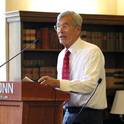
Article
Updating the Constitution: Amending, Tinkering, Interpreting
Drake Law Review
(2019)
Abstract
This is a revised version of a presentation made at the annual Constitutional Law Symposium at Drake University School of Law in April 2019.
The U.S. Constitution is now 230 years old, and it is showing its age. Its text,
taken in the sense that its enactors understood it, is, unsurprisingly, inadequate to
the needs of a large, populous twenty-first century nation. The Constitution creates
a government that is carefully insulated from the democratic preferences of the
population. It fails to vest the central government with the tools needed to manage
and regulate a vast, complicated, and interrelated society and economy. On the
other hand, it guarantees its citizens protection of only a limited set of human
rights.
Notwithstanding these blatant defects, the means provided in the
constitutional text to change it, to improve it, are insufficient to make it
appropriate for current conditions. There is reason to be skeptical of studies
purporting to measure the difficulty of constitutional amendment procedures. But
combined with an inspection of the text and the history of amendment, this
research is persuasive and supports the claim that reliance on Article V’s
procedures are unlikely to successfully reform the Constitution. On top of these
objective measures, moreover, constitutional revision in the United States is
hampered by a widely held, though uninformed, opinion that the current
Constitution is still protecting national welfare and that any change—any
tinkering—with the rules in that document bears a heavy burden of persuasion.
Reform by amendment, that is, appears to be a dead end. The U.S. judiciary,
however, has, in an important way, come to the rescue of a polity that would
otherwise be in a perpetual thrall to the principles of the eighteenth century. In
“interpreting” the Constitution, the courts have gone a long way to correct the
defects listed. But their “interpretations” have little relationship to the fixed rules
installed by the constitutional enactors. Judges have assumed what amounts to a
power of constitutional amendment. But such an amendment technique is
irregular, unpredictable, and devoid of the sanction of the “people,” past or
present, whose assent is usually thought essential to constitutional legitimacy. The
United States has escaped the disadvantages of an outdated Constitution but at the
price of subverting the constitutional rule of law.
Keywords
- constitution,
- courts,
- amendment,
- interpretation
Disciplines
Publication Date
Winter 2019
Citation Information
Richard Kay. "Updating the Constitution: Amending, Tinkering, Interpreting" Drake Law Review Vol. 67 Iss. 4 (2019) p. 887 - 907 Available at: http://works.bepress.com/richard_kay/19/
